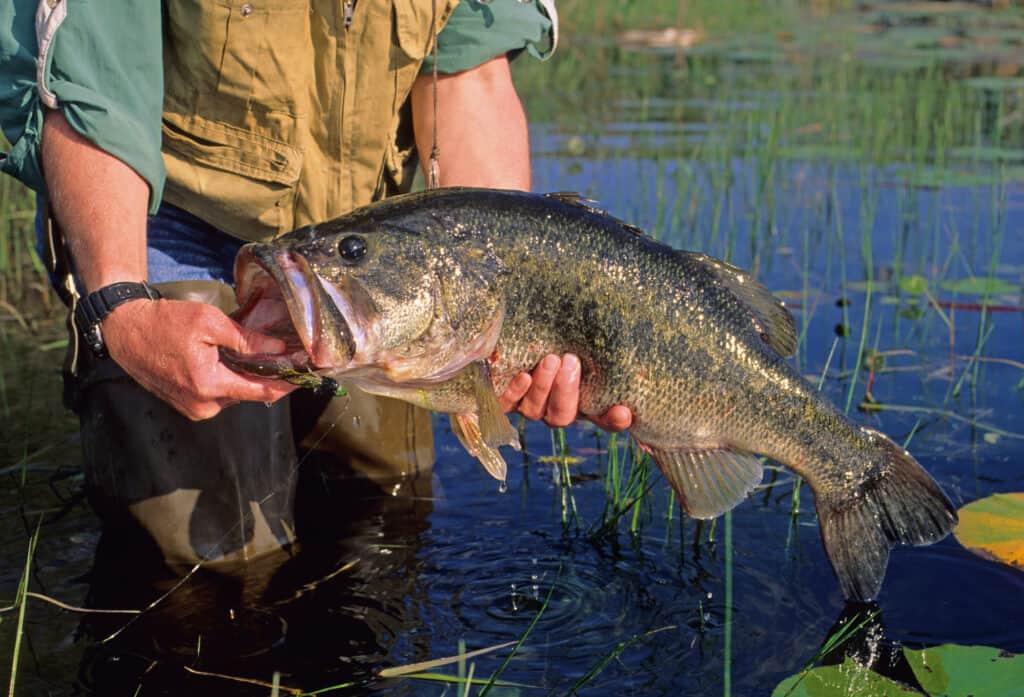Largemouth Bass
M. salmoides
Georgia, Mississippi, Alabama, and Florida all claim the largemouth bass as the state fish or state freshwater fish.
Advertisement
Largemouth Bass Scientific Classification
- Kingdom
- Animalia
- Phylum
- Chordata
- Class
- Actinopterygii
- Order
- Perciformes
- Family
- Centrarchidae
- Genus
- Micropterus
- Scientific Name
- M. salmoides
Read our Complete Guide to Classification of Animals.
Largemouth Bass Conservation Status
Largemouth Bass Facts
- Prey
- Small shrimp, bait fish, water fleas, insects, microscopic crustaceans, crustaceans, frogs, bats, worms, snakes, crawfish, younger offspring of larger fish, salamanders, small birds, mammals, and turtle and alligator hatchlings
- Name Of Young
- Fry
- Group Behavior
- Solitary
- School
- Fun Fact
- Georgia, Mississippi, Alabama, and Florida all claim the largemouth bass as the state fish or state freshwater fish.
- Most Distinctive Feature
- Large mouth, with upper jaw reaching behind the socket of the eye
- Distinctive Feature
- Mottled black stripe along the side
- Optimum pH Level
- 7.0 - 7.5
- Age Of Independence
- 1 - 5 weeks
- Average Spawn Size
- 4,000
- Habitat
- Rivers, streams, lakes, and ponds
- Predators
- Northern pike, larger bass, crappie, walleye, yellow perch, carp, channel catfish, eels, muskellunge, herons, kingfishers, bitterns, bald eagle and humans
- Diet
- Carnivore
- Lifestyle
- Solitary
- School
- Special Features
- Large mouth and mottled black stripe along the side
- Origin
- Southeastern Canada, Eastern United States, Northeastern Mexico
- Location
- North America, Asia, Africa, and Europe
- Nesting Location
- Bottom of freshwater bodies of water.
View all of the Largemouth Bass images!
Largemouth bass do have large mouths: they use them as “vacuum cleaners,” creating suction when they open them to devour their preys!
Largemouth Bass Summary
The largemouth bass, a member of the black bass (Micropterus) genus, is a popular carnivorous freshwater fish native to North America. However, it has spread as an invasive species throughout the world. Largemouth bass are not a big part of commercial fishing, as their meat is mushy and not that good. They are a very popular catch among game fishermen, though, because of their challenging aggressive behavior.
4 Largemouth Bass Fun Facts
- Although the largemouth bass is native to Eastern North America, it is considered invasive elsewhere around the world, where overzealous game fishers have introduced it.
- Georgia, Mississippi, Alabama, and Florida all claim the largemouth bass as the state fish or state freshwater fish.
- Largemouth bass are polyandrous. That means that the male mates only once, while the female mates multiple times after they reach sexual maturity.
- After protecting the eggs and newly hatched fries for four days or more, the male will get hungry and eat as many of his offspring as possible. The fish that survive will leave the nest after a few more days.
Largemouth Bass Classification and Scientific name
Largemouth bass are game fish from the Micropterus genus, commonly known as “black bass.” This genus is part of the Centrarchidae, or sunfish, family. The scientific name of the largemouth bass is Micropterus salmoides. There are two sub-species, the Florida largemouth bass (Micropterus s. floridanus) and the Northern largemouth bass (Micropterus s. salmoides), which is slightly smaller than its Florida counterpart.
Largemouth Bass Appearance
The largemouth bass has an elongated appearance. It can be a combination of gray, green, or light brown if it is in darker water. The top of the fish has an olive-colored camouflage pattern, while its side has a broad, broken pattern black stripe with green-tinged black spots on its scales. The rounded tail or caudal fin can have a black-tinged edge, especially in younger fish. Its large mouth has a long upper jaw that reaches behind the eye and a rough line of teeth on both the top and the bottom jaws. It has ten hard dorsal spines in a concave configuration, 11-14 soft dorsal rays, a pair of pelvic fins, and an anal fin with three spines and 10-12 rays. The female is larger than the male.

Largemouth bass have an olive-colored camouflage pattern on top and a black stripe with green-tinged spots on the sides.
©iStock.com/stammphoto
Largemouth Bass Distribution, Population, and Habitat
Native to Eastern North America, including Canada, the United States, and Northern Mexico, the original distribution of M. salmoides was within the river basins of the Mississippi, St. Lawrence (Great Lakes), and Red River (Hudson Bay). They also live in Atlantic Slope drainages (from North Carolina to Florida) and Gulf Coast drainages (from Southern Florida to Northern Mexico.) Largemouth bass have been introduced worldwide in Europe, Asia, and Africa, where they have damaged various habitats and are considered an invasive species.
The IUCN has listed the status of the largemouth bass as of “least concern.” There is a large species population worldwide, and considering the generational trends over the last ten years, it is considered stable.
Largemouth bass thrive in warm, freshwater bodies of water. They like to live by shallow vegetation-covered shorelines where there are a variety of submerged shelters, such as rocks and logs. Since they hunt by sight, they prefer clear waters where they can see well, rather than murky or cloudy bodies of water. They will eat any prey that can fit in their mouths, severely impacting other fish populations. In order to nest, males require a floor with a soft or impressionable composition where they can carve out a space for eggs with their tails.
Largemouth Bass Predators and Prey
Although they are efficient predators themselves, several other fish, such as northern pike, larger bass, crappie, walleye, yellow perch, carp, channel catfish, eels, and muskellunge, as well as shore birds, such as herons, kingfishers, and bitterns prey upon young largemouth bass. The bald eagle even preys upon adult bass. Apart from these, the chief predators of the largemouth bass are humans.
As previously mentioned, largemouth bass will eat almost any prey that will fit into their mouths that they use as “vacuum cleaners.” That means that younger bass will limit themselves to smaller prey, like small shrimp, bait fish, water fleas, insects, and microscopic crustaceans. Adult bass eat small fish, crustaceans, frogs, bats, worms, snakes, crawfish, younger offspring of larger fish, and salamanders. They will even eat small birds, mammals, and turtle and alligator hatchlings. They can move to deeper waters in larger lakes to pursue their prey.
Largemouth Bass Reproduction and Lifespan
Largemouth bass are polyandrous. That means that the male mates once, while the female mates multiple times after they reach about one year of age. Largemouth bass mate in the late winter or early spring from March to July, depending on the latitude and the temperature of the water, which needs to be at least a consistent 60 degrees Fahrenheit.
The male uses its tail to dig a nest in the bottom of the water body while the female waits in deeper water. Once the nest is complete, the male guides the female over the nest and keeps it there by swimming circles around it. It then prods the female to release its eggs, releasing sperm that mixes with the eggs as they settle into the nest. The male will guard the nest until the eggs hatch in a few days, after which it will guard the fries until they are ready to leave the nest, which will be about 10 days to two weeks. During that time, the male may eat a number of fries as he gets hungry. After a couple of weeks, the parents and the young fish will begin to focus on feeding.
In the wild, largemouth bass live from 15 to 23 years. They live from eight to 12 years in captivity.
Largemouth Bass in fishing and cooking
Angling enthusiasts prize largemouth bass due to their fighting nature. They will struggle against the line once hooked, including jumping out of the water to free themselves. Anglers will use a variety of lures and some forms of live bait, such as worms or minnows, to coax bass out of the shallow cover of vegetation, logs, or overhangs. It is popular among sportsmen to use the catch-and-release method to fish, especially releasing larger fish, as they tend to be females and contribute to the stock. As long as the hook is not too deep or swallowed, largemouth bass have a high survival rate after being hooked and released.
The meat of the largemouth bass tends to be white and tender, with few bones in the fillets. The taste is mild and slightly fishy. Removal of the skin and the bloodline can improve the taste, reducing fishiness. People tend to immediately like or dislike it, with more people preferring the flavor of smallmouth bass. The FDA can’t control the quality of the fish since it’s fished from so many streams across the country. That is wild largemouth bass are typically unavailable in restaurants. Higher-quality meat can be found on younger bass measuring under 12 inches. Commercial farming of the fish is not widespread, though demand is increasing in Asian markets.
Related Animals:
View all 98 animals that start with LLargemouth Bass FAQs (Frequently Asked Questions)
Do largemouth bass taste good?
The popularity of the largemouth bass is primarily due to the excitement of landing the fish rather than the flavor of the meat. The meat is white, ranging in texture from tender to mushy, and it has a slightly watery and fishy taste. The flavor can be improved by removing the scales and the bloodline.
Why are largemouth bass a problem?
Largemouth bass are considered apex predators. They eat just about everything they can fit in their mouths, causing a significant decrease in smaller water stock upon introduction. That is why they are considered invasive species outside of their native habitat.
Are largemouth bass easy to catch?
Largemouth bass are popular game fish due to their tendency to “fight” once they are hooked. They will even leap out of the water to try and dislodge a hook from their mouths. As a result, they are typically the first fish to inspire anglers to take a serious interest in sport fishing. Fishing for largemouth bass with a lure appears to be a traditional first step beyond the standard approach of fishing with a hook and bobber.
What is the difference between a bass and a largemouth bass?
Bass are fish from the Perciformes order contained within many families and genera. The largemouth bass is part of the black bass genus, otherwise known as the Micropterus genus. There are many types of freshwater and saltwater bass, the largemouth bass is simply one individual species.
How big do largemouth bass get?
Largemouth bass typically measure 11-20 inches long, weighing about 1-5 pounds. The largest recorded length for a largemouth bass was about 38 inches long, and the heaviest weight for one was 22.25 pounds.
Thank you for reading! Have some feedback for us? Contact the AZ Animals editorial team.
Sources
- , Available here: https://www.fishbase.se/summary/SpeciesSummary.php?ID=3385&AT=largemouth+bass
- , Available here: https://en.wikipedia.org/wiki/Largemouth_bass
- , Available here: https://www.britannica.com/animal/black-bass
- , Available here: https://animaldiversity.org/accounts/Micropterus_salmoides/
- , Available here: https://eol.org/pages/223475/articles
- , Available here: https://www.iucnredlist.org/species/61265/58310038
- , Available here: http://www.iucngisd.org/gisd/speciesname/Micropterus+salmoides
- , Available here: https://nas.er.usgs.gov/queries/factsheet.aspx?SpeciesID=401
- , Available here: https://nas.er.usgs.gov/queries/factsheet.aspx?SpeciesID=401
- , Available here: https://www.chefs-resources.com/?s=largemouth+bass

















